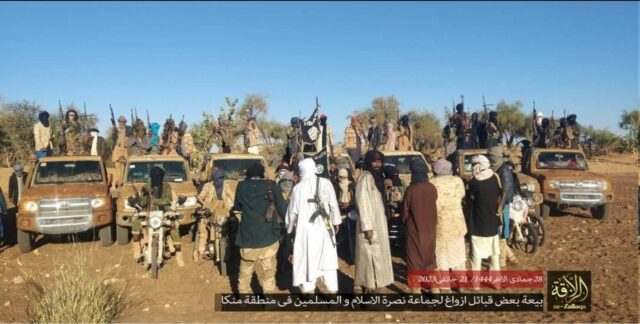
Brief: ISGS on Verge of Victory in Menaka, Mali
Publication: Terrorism Monitor Volume: 21 Issue: 9
By:

The town of Menaka, Mali has been a battleground for jihadists since the Movement for Unity and Jihad in West Africa (MUJWA) captured the town in 2012. At that time, MUJWA was an offshoot from al-Qaeda in the Islamic Maghreb (AQIM) led by Malian Arabs and Sahrawi Arabs, including Adnan Abu Walid al-Sahrawi and Abdelhakim al-Sahrawi. MUJWA eventually began to dissolve when al-Qaeda loyalist Mokhtar Belmokhtar and Adnan Abu Walid al-Sahrawi affirmed their loyalty to al-Qaeda through founding a new group, al-Murabitun, in 2013. This group lasted two years until al-Sahrawi pledged his loyalty to Islamic State (IS); Belmokhtar’s fighters remained with al-Qaeda and eventually became a component of the then-new al-Qaeda affiliate in the Sahel, Group for Supporters of Islam and Muslims (JNIM) (sahelmemo.com, December 7, 2015).
Just over a decade later, Menaka has again become a jihadist flashpoint, but this time because of the ongoing fighting between JNIM and Islamic State in Sahel Province, which is better known as Islamic State in Greater Sahara (ISGS). ISGS videos in late 2022 and 2023 have shown ISGS fighters carrying the IS-style “black flag” and fighting with JNIM around Menaka. ISGS has been progressively pushing JNIM out of the town since they began engaging them in October 2022 (imangahdien.com, October 29, 2022). In addition, by employing highly mobile groups of fighters (often using teams of motorcyclists, who receive rear support from militants in off-road vehicles), ISGS has been able to catch government-backed militias and the Malian and Burkinabe armies off-guard and overpower them (twitter.com/IbnSiqilli, March 24).
Despite the death of its two most prominent leaders, Adnan Abu Walid al-Sahrawi and Albdelhakim al-Sahrawi, ISGS in recent years is still exhibiting a high level of strategic foresight (see Militant Leadership Monitor, December 3, 2021). The way ISGS has surrounded Menaka, for example, was by first capturing the town north of it, Tidermène, and then isolating Menaka itself, such that neither JNIM nor the Malian army would be able to easily send reinforcements into Menaka (tv5monde.com, April 13). In addition, as early as 2022, ISGS had undercover fighters stationed in Menaka, who were reportedly conducting assassinations there to soften up the operational environment for an eventual takeover of the town (Twitter.com/@sonnimaga, April 13).
ISGS has one less enemy to worry about, now that France—which had called the jihadist group the top regional security threat in January 2020—has withdrawn its forces from Mali, following a breakdown in relations after that country’s government was taken over by the military in a coup (aljazeera.com, January 13, 2020). Since 2020, ISGS appeared to have been significantly weakened, in part due to the combined pressure of French, JNIM, and Malian forces. This could have opened the possibility, however remote, that JNIM would have become the predominant jihadist group in Mali and that JNIM’s leader, Iyad ag Ghaly, a former Malian diplomat, would have negotiated some form of truce (france24.com, December 6, 2012).
ISGS’s ideology, however, does not permit such truces with those they consider “infidels,” to include JNIM and the Malian government. As a result of ISGS’s resurgence, militancy in Mali will only become more severe. Imminently, however, it is Menaka that is in danger of falling into the hands of ISGS. This will serve as a major morale boost not only for ISGS, but also IS provinces in Africa and around the world more generally. ISGS’s potential conquest of Menaka will also aggravate the humanitarian situation in the area, such that aid organizations would fear providing services amid the risk of ISGS hostage-takings and ambushes (studiotamani.org, April 11).



